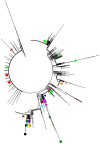Molecular characteristics of the VP1 region of enterovirus 71 strains in China
- PMID: 32818043
- PMCID: PMC7427758
- DOI: 10.1186/s13099-020-00377-2
Molecular characteristics of the VP1 region of enterovirus 71 strains in China
Abstract
Background: Enterovirus 71 (EV71) is the most commonly implicated causative agent of severe outbreaks of paediatric hand, foot, and mouth disease (HFMD).VP1 protein, a capsid protein of EV71, is responsible for the genotype of the virus and is essential for vaccine development and effectiveness. However, the genotypes of EV71 isolates in China are still not completely clear.
Methods: The VP1 gene sequences of 3712 EV71 virus strains from China, excluding repetitive sequences and 30 known EV71 genotypes as reference strains, between 1986 and 2019 were obtained from GenBank. Phylogenetic tree, amino acid homology, genetic variation and genotype analyses of the EV71VP1 protein were performed with MEGA 6.0 software.
Results: The amino acid identity was found to be 88.33%-100% among the 3712 EV71 strains, 93.47%-100% compared with vaccine strain H07, and 93.04%-100% compared with vaccine strains FY7VP5 or FY-23 K-B. Since 2000, the prevalent strains of EV71 were mainly of the C4 genotype. Among these, the C4a subgenotype was predominant, followed by the C4b subgenotype; other subgenotypes appeared sporadically between 2005 and 2018 in mainland China. The B4 genotype was the main genotype in Taiwan, and the epidemic strains were constantly changing. Some amino acid variations in VP1 of EV71 occurred with high frequencies, including A289T (20.99%), H22Q (16.49%), A293S (15.95%), S283T (15.11%), V249I (7.76%), N31D (7.25%), and E98K (6.65%).
Conclusion: The C4 genotype of EV71 in China matches the vaccine and should effectively control EV71. However, the efficacy of the vaccine is partially affected by the continuous change in epidemic strains in Taiwan. These results suggest that the genetic characteristics of the EV71-VP1 region should be continuously monitored, which is critical for epidemic control and vaccine design to prevent EV71 infection in children.
Keywords: Enterovirus 71; Genotype; Molecular characteristics; Mutation; VP1.
© The Author(s) 2020.
Conflict of interest statement
Competing interestsThe authors declare that they have no conflicts of interest.
Figures



 :HQ328793(H07)
:HQ328793(H07)  :JX025561(FY7VP5)
:JX025561(FY7VP5)  :EU812515(FY-23 K-B)
:EU812515(FY-23 K-B)  :HQ828086(C4a)
:HQ828086(C4a)  :EU753365(C4a)
:EU753365(C4a)  :KU936124(C4a)
:KU936124(C4a)  :KU936125(C4a)
:KU936125(C4a)  :KU936130(C4a)
:KU936130(C4a)  :JQ742002(C4b)
:JQ742002(C4b)  :JQ742001(C4b)
:JQ742001(C4b)  :AY207625(C3)
:AY207625(C3)  :AF376081(C3)
:AF376081(C3)  :AF304457(C2)
:AF304457(C2)  :AF376110 (C2)
:AF376110 (C2)  :AY125969(C1)
:AY125969(C1)  :AY125976 (C1)
:AY125976 (C1)  :JN874558 (C5)
:JN874558 (C5)  :KU888174(C5)
:KU888174(C5)  :U22521(A)
:U22521(A)  :GU434678(A)
:GU434678(A)  :AB059814(B1)
:AB059814(B1)  :AF135886 (B1)
:AF135886 (B1)  :AF009534(B2)
:AF009534(B2)  :AF009540(B2)
:AF009540(B2)  :AF376119(B3)
:AF376119(B3)  :AF376073(B3)
:AF376073(B3)  :AF376084(B4)
:AF376084(B4)  :AJ586873 (B4)
:AJ586873 (B4)  :AB177815 (B5)
:AB177815 (B5)  :AB177816 (B5)
:AB177816 (B5)


Similar articles
-
A novel finding for enterovirus virulence from the capsid protein VP1 of EV71 circulating in mainland China.Virus Genes. 2014 Apr;48(2):260-72. doi: 10.1007/s11262-014-1035-2. Epub 2014 Jan 19. Virus Genes. 2014. PMID: 24442718
-
Analysis of an Imported Subgenotype C2 Strain of Human Enterovirus 71 in Beijing, China, 2015.Front Microbiol. 2018 Sep 28;9:2337. doi: 10.3389/fmicb.2018.02337. eCollection 2018. Front Microbiol. 2018. PMID: 30323801 Free PMC article.
-
[Isolation and sequencing of VP1 region of enterovirus 71 strains in Zhejiang, China].Zhonghua Liu Xing Bing Xue Za Zhi. 2005 Dec;26(12):971-4. Zhonghua Liu Xing Bing Xue Za Zhi. 2005. PMID: 16676593 Chinese.
-
Complete genome analysis of the C4 subgenotype strains of enterovirus 71: predominant recombination C4 viruses persistently circulating in China for 14 years.PLoS One. 2013;8(2):e56341. doi: 10.1371/journal.pone.0056341. Epub 2013 Feb 18. PLoS One. 2013. PMID: 23441179 Free PMC article.
-
Human enterovirus 71 epidemics: what's next?Emerg Health Threats J. 2013 Sep 10;6:19780. doi: 10.3402/ehtj.v6i0.19780. Emerg Health Threats J. 2013. PMID: 24119538 Free PMC article. Review.
Cited by
-
Recent Molecular Epidemiology of Echovirus 11 Throughout North and West Africa Resulted in the First Identification of a Recombinant Strain from an Acute Flaccid Paralysis Case in West Africa.Viruses. 2024 Nov 13;16(11):1772. doi: 10.3390/v16111772. Viruses. 2024. PMID: 39599886 Free PMC article.
-
Self-Assembled Multi-Epitope Peptide Amphiphiles Enhance the Immune Response against Enterovirus 71.Nanomaterials (Basel). 2020 Nov 25;10(12):2342. doi: 10.3390/nano10122342. Nanomaterials (Basel). 2020. PMID: 33255791 Free PMC article.
-
Molecular epidemiology and clinical features of hand, foot and mouth disease requiring hospitalization after the use of enterovirus A71 inactivated vaccine in chengdu, China, 2017-2022: a descriptive study.Emerg Microbes Infect. 2022 Dec;11(1):2510-2519. doi: 10.1080/22221751.2022.2125346. Emerg Microbes Infect. 2022. PMID: 36103331 Free PMC article.
-
Molecular evolutionary dynamics of enterovirus A71, coxsackievirus A16 and coxsackievirus A6 causing hand, foot and mouth disease in Thailand, 2000-2022.Sci Rep. 2023 Oct 13;13(1):17359. doi: 10.1038/s41598-023-44644-z. Sci Rep. 2023. PMID: 37833525 Free PMC article.
-
Enterovirus 71-Associated Infection in South Vietnam: Vaccination Is a Real Solution.Vaccines (Basel). 2023 May 3;11(5):931. doi: 10.3390/vaccines11050931. Vaccines (Basel). 2023. PMID: 37243035 Free PMC article.
References
-
- Solomon T, Lewthwaite P, Perera D, et al. Virology, epidemiology, pathogenesis, and control of enterovirus 71. Lancet Infect Dis. 2010;10(11):778–790. - PubMed
LinkOut - more resources
Full Text Sources
Other Literature Sources
Miscellaneous

